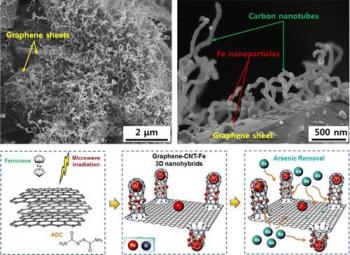Researchers from Korea suggest a new simple, high-yield method (single-step microwaves radiation) to synthesize a new graphene-carbon nanotube-iron oxide (G-CNT-Fe) 3D functional nanostructures. The researchers report that these unique 3D structures can be excellent arsenic absorbents.

Those structures are carbon nanotubes vertically standing on graphene sheets and iron oxide nanoparticles well distributed on both the graphene and the CNTs. These are excellent to absorb arsenic due to the high surface-to-volume ratio and open pore network.
This isn't the first graphene based material useful to remove arsenic from water. In 2010, another Korean research developed a composite material made from reduced graphene oxide and magnetite that could effectively remove arsenic from drinking water. That magnetite composite was used to remove over 99.9% of arsenic in a sample. The composite can be dispersed in water, and then removed after it has absorbed the arsenic (by using a permanent hand-held magnet).
Graphene can also be used to desalinate water. Lockheed Martin developed a new energy-efficient graphene-based water desalination technology that they aim to commercialize by 2014-2015. In May 2013 we reported on a new company (American Water Recycling) that uses University of Texas in El Paso (UTEP) technology that can be used to create graphene membranes that can extract grease from water and clean it.
Source: Nanowerk

